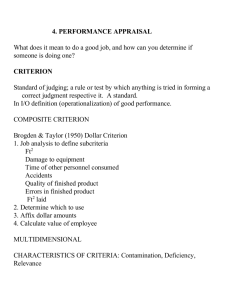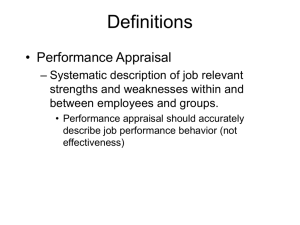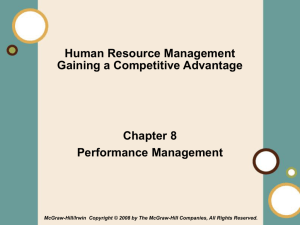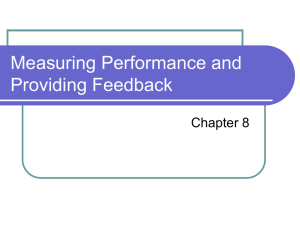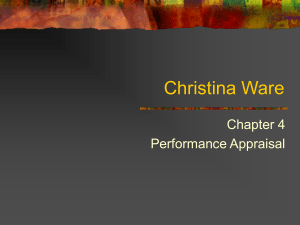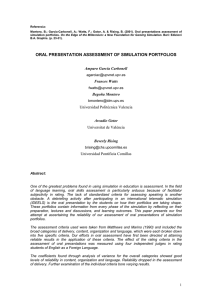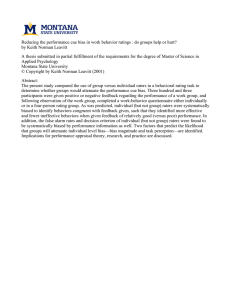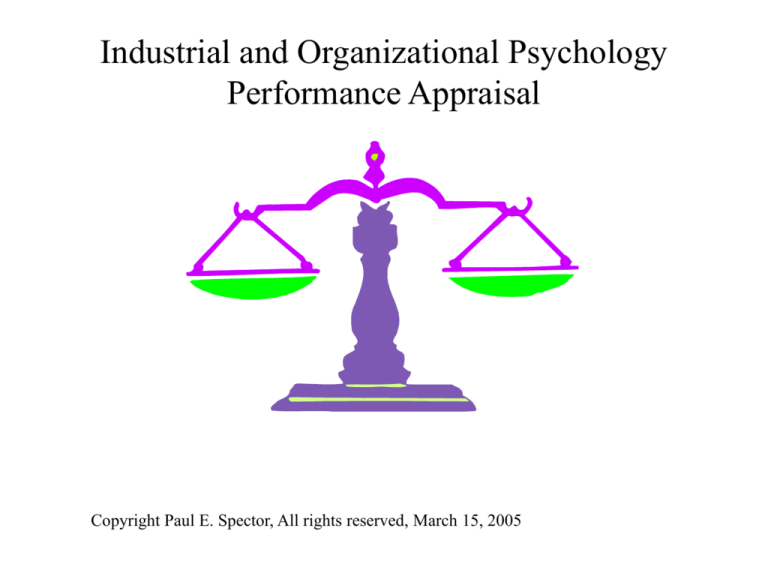
Industrial and Organizational Psychology
Performance Appraisal
Copyright Paul E. Spector, All rights reserved, March 15, 2005
What Does It Mean To Do a Job?
• Criterion: Standard of judging; a rule or test by which anything is
tried in forming a correct judgment respective it.
• Single Criterion: Global measure to represent performance
• Composite criterion: Combination of individual subcriteria
–
–
–
–
Requires common metric
Brogden & Taylor (1950) Dollar Criterion
Convert each subcriterion to money
Requires quantification of subcriteria
• Multidimensional
– Each person gets multiple scores that aren’t combined
Characteristics of Criteria
• Theoretical criterion: Conceptual definition of performance
• Actual criterion: How performance is assessed
• Relevance: Actual assesses the theoretical
• Contamination: Actual measures something other than the
theoretical
• Deficiency: Actual fails to capture the theoretical
Performance Appraisal
• Determination and Documentation of Individual's
Performance
•
Should be tied directly to criteria
• USES
–
–
–
–
–
Administrative decisions (promotion, firing, transfer)
Employee development and feedback
Criteria for research (e.g., validation of tests)
Documentation for legal action
Training
Objective Methods
• Counts of behaviors or outcomes of behaviors
• Advantages
•
Consistent standards within jobs
•
Not biased by judgment
•
Easily quantified
•
Face validity-bottom line oriented
• Disadvantages
•
Not always applicable (teacher)
•
Performance not always under individual's control
•
Too simplistic
•
Performance unreliable--Dynamic
•
Criterion
Subjective Methods
• People’s judgments about performance
• Trait based graphic rating scale
• Behavior based: Critical incidents
•
Mixed Standard Scale
•
Behaviorally Anchored Rating Scale
•
Behavior Observation Scales
• Problems:
•
Rating errors: Leniency, Severity, Halo
•
Supervisor subversion of system--leniency as a strategy
•
Mixed purposes (feedback vs. administrative)
•
Negative impact of criticism
Rater Error Solutions
• Error resistant rating forms
–
–
–
–
Behaviorally Anchored Rating Scale, BARS
Behavior Observation Scale, BOS
Mixed Standard Scale, MSS
Research does not show these forms to be successful in eliminating errors
• Rater training
– Rater error training: instructs raters in how to avoid errors
• Reduces halo and leniency error
• Less accuracy in some studies
– Frame of reference training: Give raters examples of performance and
correct ratings
• Initial research promising in reducing errors (Day & Sulsky, 1995)
Sound Performance Appraisal Practices
• Separate purposes
– Raises dealt with separately from feedback
•
•
•
•
•
Consistent feedback, everyday
Limit criticism to one item at a time
Praise should be contingent
Supervisors should be coaches
Appraisal should be criterion related, not personal
Technology
• Technology helpful for performance appraisal
• Employee performance management systems
–
–
–
–
•
Web-based
Automated—reminds raters when to rate
Reduces paperwork
Provides feedback
360-degree feedback systems
– Ratings provided by different people
•
•
•
•
Peers
Subordinates
Supervisors
Self
– Big clerical task in large organizations to track/process ratings
– Web makes 360s easy and feasible
– Consulting firms available to conduct 360s
Legally Defensible Performance Appraisal
• Performance appraisals can be legally challenged
– Organizations lost 41% of cases—Werner & Bolino 1997
• Practices that minimize legal challenges
– Job analysis to define dimensions of performance
– Develop rating form to assess dimensions from prior point
– Have written instructions
– Train raters in how to assess performance
–
–
–
–
Use multiple raters
Management review ratings and allow employee appeal
Document performance and maintain detailed records
Provide assistance and counseling

